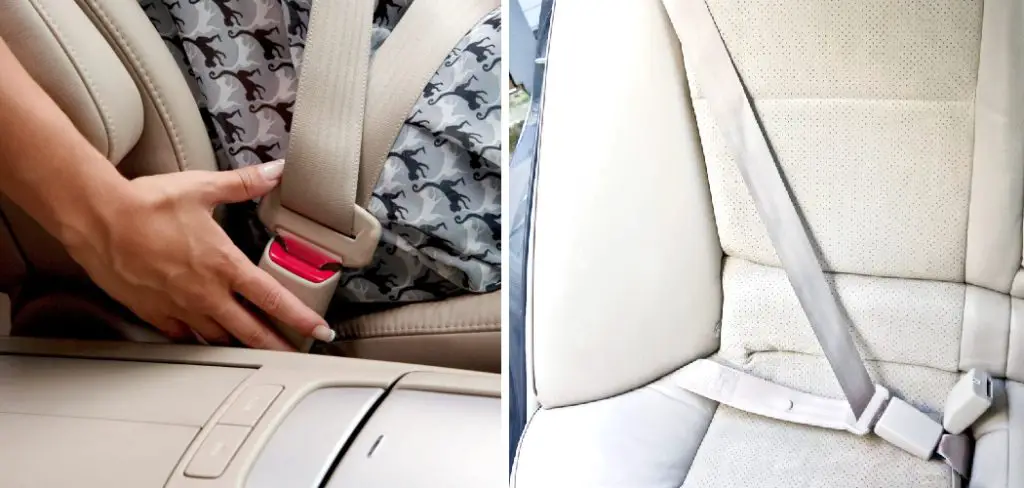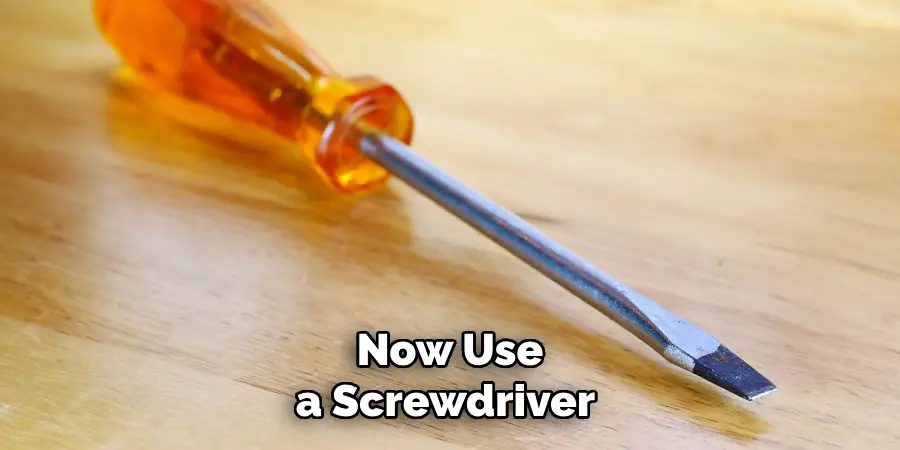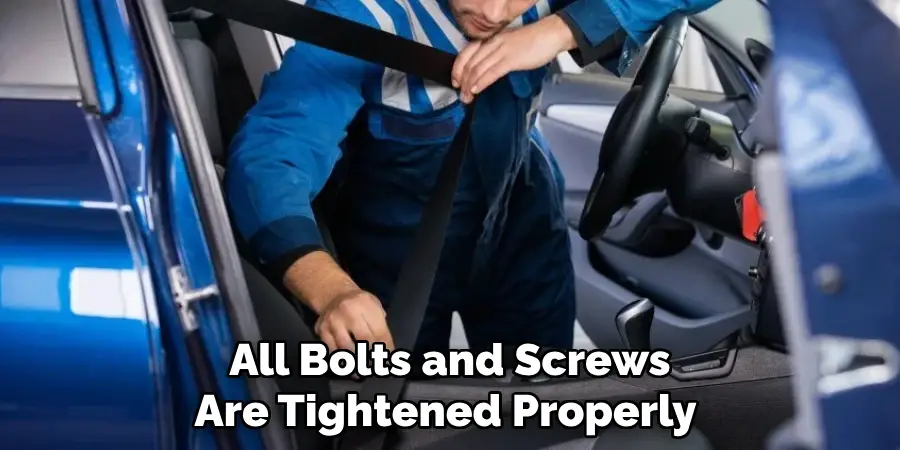Are you stuck in a frustrating situation with your car’s seat belt? Are you frantically trying to find out how to fix it, but don’t know where to start? Don’t worry – we’ve got you covered! In this blog post, we’ll go through the steps of fixing a locked seatbelt and help get your back on the road again as quickly as possible. Has it been locked in place and just won’t move, no matter how hard you tug on it?

From advice on diagnosing why it won’t open or close correctly and easy fixes for minor problems, to more complex repair options for unusual issues – we guide you through the process of getting your car ready for whatever life has next. So buckle up and let’s get started! Keep reading to find out how to fix a seat belt that is locked so that it’s ready for use once again!
Why Does Seat Belt Get Locked?
1. Improper Installation
A seat belt can get locked for many reasons, such as a faulty system, improper installation, or wear and tear. No matter what the cause is, it’s important to understand why it happened in order to avoid future incidents. It’s also helpful to know how to fix a seat belt that has become locked so you don’t have to worry about your safety while driving.
Improper installation is the most common reason for a seat belt getting locked. For example, when installing the seat belt, it may not be connected properly, or the buckles may have been incorrectly placed in the wrong slots. If this is the case, then you will need to reinstall your seat belt and make sure that all of its components are correctly aligned.
2. Wear and Tear
Another common reason for a seat belt to get locked is due to regular wear and tear. This happens when the belt starts to fray or become worn over time, which can cause it to jam up and eventually lock. If your seat belt has been exposed to high temperatures or sunlight, then this could also be an issue, as these elements can cause the seat belt to become brittle and break.
3. Faulty System
Finally, a faulty system is another common reason for a seat belt getting locked. This happens when the internal mechanisms of the seat belt start to fail or malfunction. This could be due to a number of things, such as an aging system, poor quality parts, or even a manufacturing defect.

Required Items
Before attempting to fix a seat belt that is locked, have the following items ready:
- Safety glasses or goggles
- A pair of needlenose pliers
- A small flashlight
- An assortment of screwdrivers and/or Allen wrenches
- A rust-removing lubricant such as WD-40
How to Fix a Seat Belt That is Locked in 10 Easy Steps
Step 1: Inspect the Seat Belt
Start by inspecting the seat belt for any visible damage. If you notice a tear, frayed edges, or any other type of external damage to the belt, it will need to be replaced completely as attempting to fix it could cause further damage and result in even more serious safety issues.
Step 2: Check the Connectors and Buckles
Now inspect the connectors and buckles of the seat belt. Make sure all pieces are securely connected and that there are no loose parts or damaged components. Also, check for any signs of rust, as this could indicate that the belt is in need of replacement.
Step 3: Lubricate the Moving Parts
Next, lubricate the moving parts of the seat belt with rust-removing lubricant. This will help to free any stuck or jammed components and ensure that they are able to move freely without becoming locked again.
Step 4: Check for Blockages
Now check for any blockages or obstructions which could be preventing the seat belt from functioning properly. If there are any, carefully remove them and check that all of the components can move freely again.
Step 5: Tighten the Bolts
Now use a screwdriver or Allen wrench to tighten any loose bolts or screws on the seat belt itself. Make sure they are not too tight, as this could cause further damage, but they should be tight enough to keep everything secure.

Step 6: Check the Spring Mechanism
Next, check that the spring mechanism of the seat belt is working properly. If it is not, then you will need to replace it as soon as possible in order to ensure your safety while driving.
Step 7: Test the Seat Belt
Now that you have inspected and lubricated all of the components, test the seat belt to make sure it is working correctly. Pull on it gently to see if it is able to move freely without getting locked again.
Step 8: Check for Leaks
Once you have tested the seat belt and ensured that it is free from any obstructions, check for any possible leaks. If there are any, then you will need to get them fixed as soon as possible in order to ensure that the seat belt is functioning properly.
Step 9: Replace Any Damaged Parts
If there are any parts of the seat belt that have become damaged or worn out, then you should replace them as soon as possible. This will help to ensure that the belt is safe and secure when you are driving.
Step 10: Re-Install the Seat Belt
Finally, re-install the seat belt in its original position. Make sure all of the components are connected securely and that all bolts and screws are tightened properly before using it again.

By following these ten steps, you should be able to fix a seat belt that is locked and ensure your safety while driving. Remember to always inspect the seat belt regularly for any signs of wear and tear and replace any parts as needed in order to keep it functioning properly. Doing so will help to prevent future incidents from occurring. With this information, you can now drive with peace of mind.
8 Safety Measures to Follow
Unlocking your seat belt should not take more than a few seconds and is usually quite straightforward. However, sometimes the buckle can get stuck in the locked position, which might require some extra effort to fix. With that said, it’s always important to remember safety first and follow these steps when trying to resolve a locked seat belt:
- First and foremost, always make sure your vehicle is parked in a safe spot. This is especially important if you are attempting to fix the seat belt while the engine is running. Also, double-check that the handbrake is firmly engaged.
- Make sure the area around the buckle is clean and free of any debris or objects that might interfere with its movement. For instance, if there are any crumbs or dirt blocking the mechanism, use a small brush to remove them.
- When you’re ready to start, press the red release button firmly and jiggle the belt back and forth. If this doesn’t work, try putting a little bit of pressure on the buckle itself while gently pushing the button in with your thumb.
- If none of these techniques are successful, you might need to resort to using some lubricant or oil. A light, silicone-based lubricant will do the trick in most cases, and it’s perfectly safe to use on seat belts.
- If your car is equipped with an airbag system, you should never attempt to fix a locked seat belt while the engine is running. This can cause serious damage to the airbag components and make them unusable in the event of an accident.
- If the seat belt still won’t budge after trying all of these methods, you might need to call for a professional mechanic to take a look at it. They will be able to safely and properly fix the issue in no time.
- After everything is back in working order, make sure that you test out the seat belt to make sure it is functioning properly. Pull sharply on the strap and check for any signs of resistance or difficulty in releasing.
- Finally, always remember to buckle up every time you get behind the wheel, and never take your safety lightly!

By following these steps, you should be able to safely unlock a stuck seat belt without any problems.
Conclusion
After following the steps on how to fix a seat belt that is locked outlined in this post, you should no longer have trouble with a seat belt that is locked. Remember to practice safety first and foremost – regular inspection of your car’s protective systems is a must for optimal protection. In the end, a few minutes of your time can make a huge difference in keeping you and your passengers safe when on the road.
Be sure to do the necessary maintenance and earth-friendly measures to make sure you keep up with all those pesky repairs and have an efficient system. Most importantly, knowing how to fix a seatbelt that is locked gives peace of mind to both you and your passengers, so always act responsibly while driving.
